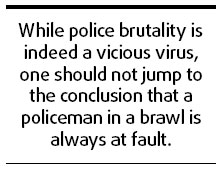By Raymond Zhou

What started as an open-and-shut case of police brutality has morphed into a Rashomon where truth is elusive.
The fatal incident took place around 10 pm on October 11 in the northeastern city of Harbin, Heilongjiang province. Two groups of young men got into a ruckus at a local watering hole. One of them was killed.
Tragedies of such random violence occur everyday all around the world and usually do not draw public attention. Add one dramatic element, and things take a dramatic turn.
It was revealed the day after that one group - of six young men - was made up of policemen and the other college students.
Online reaction was swift and unanimous: It was a demonstration of police brutality and must be condemned.
A day later, a local television station aired a clip of the melee recorded by a closed circuit security camera. The group of students was exposed as being quite aggressive, especially the victim, who clearly initiated many of the attacks, while the policeman, in plainclothes (possibly off duty), were initially restrained.
The pendulum of public opinion quickly swung.
Many saw the policemen's acts as self-defense and argued that 22-year-old victim Lin Songling should bear some of the responsibility for his own death.
Then an unverified report emerged that Lin was the son of a rich businessman.
He drove a Mercedes and would soon report for a cushy government job.
All the students were from a sports college, meaning they were all physically strong. Lin himself stood 1.92m and majored in basketball.
In light of this, the tide of public reaction flowed very much toward policemen.
This incident is a reminder that one should have a sense of justice but should not be carried away by it before the whole truth emerges.
The case made headlines mainly because people first perceived it as a struggle between the strong and weak.

When you mention a college kid beaten to death by cops, it conjures up the ghost of Sun Zhigang and the 2003 Guangzhou incident that set a benchmark for tackling the police brutality problem. While police brutality is indeed a vicious virus existing in our society, one should not jump to the conclusion that a policeman in a brawl is always at fault.
What if there had been no video recording of the clash? To appease public anger, the court probably needs to dole out a harsher penalty than warranted.
If you dig deeper, the video does not provide sufficient evidence that can exonerate the cops.
The crucial "blows" that caused Lin's death occurred out of sight of the camera. And if there were no third-party witnesses around, it would be party A said, party B said.
When I travel around the country, I encounter stories of corruption, ineptitude and various forms of social ills, yet many cases are not as black-and-white as they would have appeared had I stayed in my office and commented on them. To apply a framework of class struggle on every conflict would achieve nothing except giving oneself a false sense of moral superiority.
Before the whole truth comes out, let's play a game of fictional twists: Lin was an orphan adopted by a self-made entrepreneur who had given generously to the Sichuan earthquake relief; the policemen came from poor families and recently risked their lives saving children from a fire. Now, give each of them a negative background story.
Mind you, these made-up tidbits have nothing whatsoever to do with who's guilty, yet they could well sway the court of public opinion.
E-mail: raymondzhou@chinadaily.com.cn
(China Daily 10/18/2008 page4)
我要看更多专栏文章